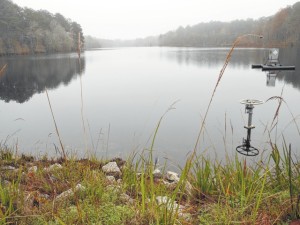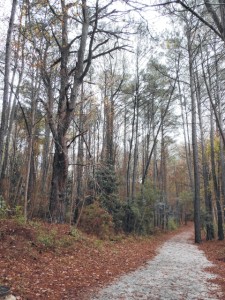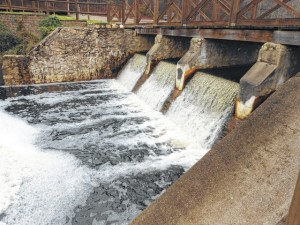By Tom MacCallum – For the Daily Journal

This view from an airplane of the Rockingham CCC camp in July 1939 shows four large barracks for enrollees in the center of the site.
ROCKINGHAM — The Nona Lee “Pitt” Hinson Cohen Wildlife Conservation Area at Hinson Lake is a place now developed for recreation and nature study.
It is a collaborative effort supported by the North Carolina Wildlife Resources Commission and the city of Rockingham.
It is not widely known that the area was first created by African-American men in the 1930s. They were mostly veterans from the U.S. military who joined the Civilian Conservation Corps, or CCC, during the Great Depression.
Development of the lake was a spare-time project for the men. Their main job was to save farmland in Richmond County from erosion.
Just as they were praised for the excellent work they did saving land, they were praised for the construction of the dam and spillway to create the lake.
Hinson Lake remains as a testimony to the character of the work of some 200 African-American men in CCC Soil Conservation Service Camp No. 22 in Rockingham.

Hinson Lake is a 30-acre pond contained by a dam created by hand in the 1930s by African-American men from the nearby CCC camp.
THE BEGINNING
On July 4, 1935, Henry C. Wall offered to lease 15 acres for the CCC camp on the northeastern outskirts of Rockingham for $1 a year.
“When the matter of a CCC camp for Rockingham was first broached and given consideration, it was understood that it would be for white young men between the ages of 18 and 25,” the Rockingham Post-Dispatch reported July 18, 1935.
It was promoted as a “boom to Rockingham,” at least by the merchants who stood to profit from it. It invoked a real feeling of enthusiasm. But some residents were opposed to it being so close to a residential area.
“Perhaps no one thing in years has been brought here that would mean more to the town than getting this camp,” Ike London wrote in his Dispatch newspaper.
Wall’s property was immediately accepted for the camp by federal authorities.
The CCC men would be doing badly needed soil erosion and forestry work throughout Richmond County under the guidance of the Soil Erosion Service, U.S. Department of Agriculture.
The Rockingham Merchants Association endorsed the camp for white boys.

Originally, a road was on top of the Hinson Lake dam. Now there is only a hiking and running pathway.
CHANGE OF PLANS
Then, on July 18, 1935, the Dispatch announced that what was originally to be for white young men, was to be for “Negro young men.”
Because of the race change, a new site had to be selected. It shifted to 12 acres a half mile east of the town limits owned by Mrs. B. F. Palmer, which today includes the Cohen Conservation Area.
“And it is not in a white-settled section. It is contiguous to the colored part of town,” the Dispatch said. It turned out to be a good move, because the north prong of Falling Creek ran through the property.
Restrictions on trainees included having to enter Rockingham only by East Washington Street. Military officers in charge of the camp were to be white. Men were to be subject to the “usual military restrictions.”
By Sept. 13, 1935, the camp was dedicated in honor of U.S. Army Maj. Seawell M. Corbett, a surgeon at Fort Bragg who was involved in the project. By then there were 154 at the site of more than 200 men to eventually fill the camp.

Trees on the northeast side of Hinson Lake were originally planted by CCC men as part of a beautification/landscaping effort.
PRE-FAB BUILDINGS
The first camp cadre had arrived July 30, 1935, to prepare the site. The city of Rockingham loaned a grading machine for the work on the campsite until one could be obtained from CCC district headquarters in Wadesboro.
Work included cleaning up the “swamp” at the south end of the site, which would later include what is Hinson Lake. Roads were constructed into the camp. A wetlands still exists today below the dam spillway extending under Long Drive and under Rockingham Road to the water plant.
“It is understood that this area will be landscaped and beautified with the view to establishing a park adjacent to the camp proper,” the Dispatch said on Aug. 8, 1935.
By Aug. 22, 1935, 14 carloads (presumably railroad cars) of panel lumber arrived in Rockingham from Bogalusa, Louisiana, “and are being bolted together for the 16 buildings that will house the 200 trainees.”
The lumber was creosoted and caused quite a number of local workers to suffer blisters. Water, sewer and electricity was available at the site. Rockingham expected payments of from $50 to $75 a month for water.
At the same time, a meeting of farmers was held Aug. 9 at the Richmond County Courthouse to form the Richmond County Soil Erosion organization, which remains today as the Richmond County Soil and Water Conservation District.
While the camp was under construction, the first 87 Negro ex-servicemen arrived and were housed in military tents at the edge of the campsite. Before the end of that week, all 200 were expected to have arrived. All were vaccinated and given physicals.
“The men are being brought from Tennessee, Georgia, Florida, South Carolina and North Carolina,” the Dispatch said.
There were four barracks 20 by 130 feet, a lavatory and bath 20 by 35 feet, a latrine 20 by 25 feet, a mess hall and kitchen 20 by 160 feet, a dispensary 20 by 30 feet, a 20-by-60-foot school and several supply, storage and administrative buildings; 16 in all.
The 16 white staff members lived with their families in the community. In addition to administrative personnel, there was an agronomist, draftsman, mechanic and construction engineer.

Stone and cement foundations from CCC Camp No. 22 in Rockingham are still visible at the turnaround on the road from East Washington Street to the Rotary lodge.
LAKE’S ORIGIN
Men from the CCC camp were here for soil conservation services. But, there was an additional benefit added to the Palmer land. That land was — until donated to the state in recent times — former property of the family of M. L. Hinson, a local businessman and Richmond County sheriff from 1904 to 1912, who died in office.
A headline in the Dispatch April 8, 1937, stated, “POND FINISHED.”
The subhead stated: “Gates Closed April 2nd on CCC 30-acre Pond Just East of Rockingham, and Pond Quickly Filled. To be Stocked with Fish.”
For some months prior to that, during more or less idle periods due to rains halting work on farm conservation efforts, “the men of the CCC ex-service Negro men’s camp on the eastern outskirts of Rockingham have been engaged in building a big dam across Falling Creek,” the Dispatch said.
It took only three days for the pond to fill 30 acres, and “it is indeed a pretty body of water,” London wrote.
The dam was built wide enough to permit a new road to pass over it from the County Home (now a vacant building to the south of Richmond Memorial Hospital) to U.S. 1 near Eastside Cemetery.
The pond was built on the Palmer-Hinson property with the understanding it would be open to the public under proper fishing regulations.
Above the lake was Rockingham’s, then and now, water lake.
With fish-stocking of the pond by the U.S. government, “This is going to be a fisherman’s paradise in course of time,” London said.
Just before the pond opening, CCC men completed planting the area on the northern hillside of the lake in dogwood, maple and live oaks; and built and surfaced a winding road from the camp down to the dam road.
“It is a worth-while project — a pond to stay when many of us have long since gone; and built, too, at idle moments that have not interfered with any of the CCC work on the farms of the county,” London said.
“It is a community project, to be of benefit to the county as a whole,” he added.
A benefit to the CCC men was that they would have a place to swim and bathe during the summer.
Not only that, Rockingham got its first police car because of the distance of the CCC camp from town, just in case police had to get there in a hurry.

Photos contributed by Tom MacCallum Sturdy stone and cement put in place by CCC African-Americans in the 1930s on the Hinson Lake Dam spillway remain in place to maintain a viable spillway. Before property was opened in recent years for recreation, the dam and spillway were reinforced for safety by engineers.
CONSERVATION WORK
The main interest of the CCC men was soil erosion work by teaching farmers through hands-on projects how to terrace fields, improve gullies, create diversion ditches, plant trees improving timber stands and perform other farm work.
On Dec. 12, 1935, the Dispatch announced the U.S. government was discontinuing camps and Rockingham’s was on the closure list after existing just three months.
“Such a howl was raised in Richmond County over the closing of this camp, and Congressman (John W.) Lambeth became so active, that the canceling orders were obtained,” the Dispatch said.
London said, “There is a vast need for soil erosion work in Richmond County, and the 200 men composing the CCC ex-service camp have been doing a fine work on the farms since its establishment in September 1935.”
He said, “The work being done is proving so acceptable and of such a valuable nature that the farmers are clamoring for its continuance. And here is a matter that will cause grave concern to our Richmond County people who by now realize just how valuable this free soil conservation work is proving to be.”
The camp got a reprieve, at least through March 31, 1937, and then extended to July 1. Two months before, enrollment at the camp increased to 250. There was no local opposition to the extension of work or expanding number of men. The 250-strong ex-service African-Americans had worked themselves into the community as essential.
Rockingham Mayor B.F. Reynolds had been, “at first skeptical of the desirability of a camp manned by Negroes,” the Dispatch said, “Later, after conferring with Maj. (S.M.) Corbett and discussing the matter with various citizens, he reached a favorable conclusion.”
Reynolds said Rockingham could “ill afford to turn its back on such a venture. Our people will exert every effort to see that this camp remains undisturbed.”
The Rockingham camp still existed in 1939, but conservation work was shifting to the CCC camp in Hoffman in 1939 which then closed in 1941 when U.S. Army maneuvers occupied much of the county.
Later in the 20th century, the Palmer-Hinson family donated Hinson Lake and surrounding land to the N.C. Wildlife Resource Commission, which in cooperation with Rockingham, developed the wildlife conservation area.
The centerpiece of that area today is the lake created by the African-American CCC enrollees out of a swamp. Water still backs up to their dam and flows over the spillway they created. It is their legacy to Rockingham, Richmond County and North Carolina.
Tom MacCallum is a member of the Richmond County Historical Society.
